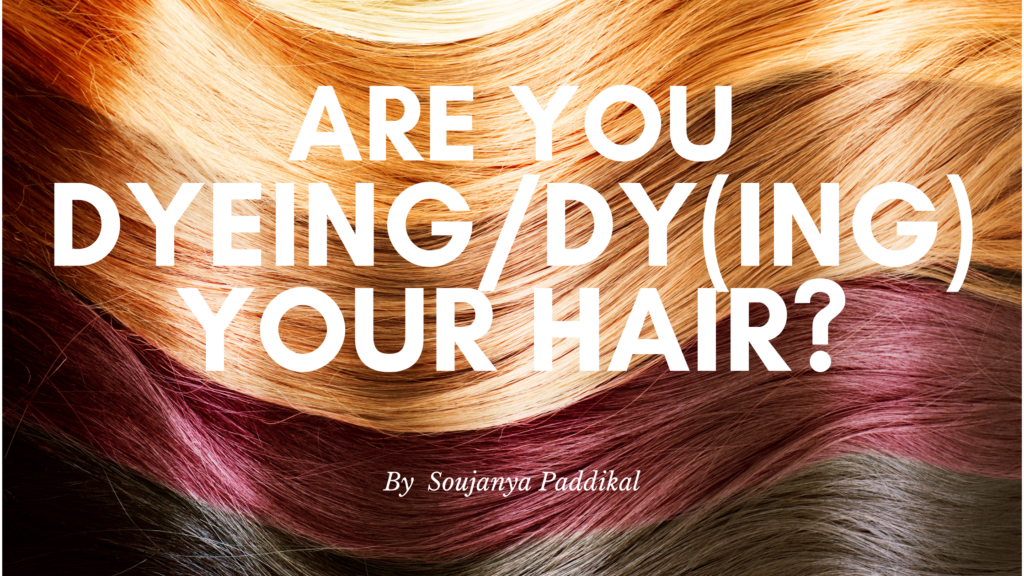Health & Wellness, Herbs, Personal Care
Are you dye/dy (ing) your hair?
By Soujanya Padikkal
News of a family wedding and my mother pesters me to buy her a hair color to cover her graying hair. Humans have dyed their hair for thousands of years, experimenting with formulas to achieve a new hair colour. Auburn/Red/Green/Violet/Purple or streaks of different colors, you might have seen them all. The practice of hair dyeing started with the purpose of covering white or grey hair and over the decades has turned into a fashion statement.
In recent times, the usage of hair colours/dyes has increased significantly and extensively among all age groups. This makes it essential for us to develop an understanding of this product to assess its risk profile for our own good. But before we understand the composition of hair dyes and how they function, it is important for us to understand the basic anatomy of hair.
Hair is made up of root and shaft. When you colour the hair, it is the shaft which is coloured and not the root. The shaft is made up of three layers namely cuticle, cortex and medulla. The medulla is a hollow core, cortex contains the natural colour pigments (i.e. Melanin which determine the colour of the hair), and cuticle which is the outer layer of the shaft. When you use colouring agents, it either rips off the natural colour from the hair shaft, adds a new colour or does both.
Even though, we use the words hair dye and hair color interchangeably, there is technically a distinction between the two based on its mechanism of action on the hair. While hair color superficially coats your hair i.e. it colors the outer layer of hair (cuticle), hair dyes penetrate the inner layer of your hair (cortex); hence they last longer.
Hair coloring can be categorized based on color permanence as: temporary, semi-permanent, demi-permanent and permanent.
| Hair dye type | Color development | Duration |
| Temporary (ideally a hair color) | Just coats the hair shaft with desired color. Doesn’t penetrate cuticle | Color can be removed with one wash also |
| Semi-permanent | Color is deposited on and in the cuticle | 4-12 washes before fading |
| Demi-permanent | Opens the cuticle and allows dye to penetrate slightly into cortex | 12-24 washes before fading |
| Permanent | Opens cuticle and deposits dye molecules in cortex | Until new hair grows |
Now that we have understood how a hair colour or hair dye functions, let us understand the key ingredients which enable this action.
Most common Ingredients in hair dye
Hair dyes/colours contain several chemicals in varied combinations depending upon the permanence of colour to be achieved to either bleach the hair and then colour or just colour.
- Ammonia – It separates the cuticle and allows the hair colour to penetrate the cortex of the hair. Ammonia free hair dyes contain chemicals like monoethanolamine (MEA). It performs the same function as ammonia of opening the cuticle. (But there are studies that show that MEA is even more harmful than ammonia. So pick your poison!)
- Hydrogen peroxide – It is known as the developer as it helps initiate the color forming processes and creates longer lasting colour. Peroxide is used to bleach the hair as it removes the natural color of the hair. Another colorant is used alongside to introduce the desired hair color.
- Paraphenylenediamine (PPD)– Invention of PPDby Eugene Schuller gave rise to one of the most successful hair product giants – L’Oreal. It is widely used in hair colorants and is needed for almost all shades but undeniably for darker shades. It is one of the many coal-tar colors derived from petroleum. PPD is used as one of the primary coloring agents.
- Resorcinol –This chemical is also used in permanent hair color products. It reacts with peroxide to bond the dye permanently to the hair.
While ammonia was a common ingredient in permanent hair dyes initially, companies have started to offer ammonia-free hair colour options, however, the function of the substitutes used are the same of opening the cuticle.
Side-effects of chemical based hair coloring
Hair coloring might seem like a benign activity. But, it isn’t. The fact that it basically involves opening the cuticle in itself is self-explanatory to the damages that will follow with regular hair coloring. Lets look at the side-effects of chemical based hair coloring:
- Frequent and regular application of hair colour (even if temporary hair colour), can damage your hair in the long run. Due to constant application, the natural colour and texture of hair is compromised.
- PPD is a common allergen. Contact with skin causes redness, burning, sores, and itching. Studies also link it to lupus (auto-immune disease), lymphoma(cancer) and asthma. There are studies that also show that hair-dressers exposed to PPD had a greater risk of bladder cancer.
- Ammonia can lead to dull, brittle, dry and unhealthy hair as it serves to break through the cuticle. It’s also known to cause allergic reactions, dermatitis, burns and trigger respiratory problems. Products that say “no ammonia/peroxide” just use a substitute which eventually performs the same function and hence is not damage-free.
- As hair dying involves penetration of chemicals into the hair shaft it can lead to hair loss, dry scalp, frizzy hair, flakes not to mention the numerous health risks it poses to the skin.
- Studies show that hair dyes may increase the risk of some cancers in women.
In recent times, the usage of hair dyes has increased significantly due to a higher disposable income and growth in fashion-consciousness among both men and women. What is more worrying is that even children have started applying them “for fun. Even if one needs to colour their hair, opting for natural herbs like henna, indigo, etc, would be the right choice (note: henna and “black henna” available in the market are not the same. Black henna has dye). These have been used for centuries as coloring agents. No doubt, their application is tedious, but they do not alter the natural chemical make-up of your hair and do not expose you to any health hazards. ”. In a bid to achieve the desired cosmetic appeal, let us not turn a blind eye to the long term problems we are exposing ourselves to.
Stay natural, stay healthy, safe and beautiful!
Disclaimer: The article is based on the author’s understanding of hair dyes and colors. Please feel free to point out errors.

